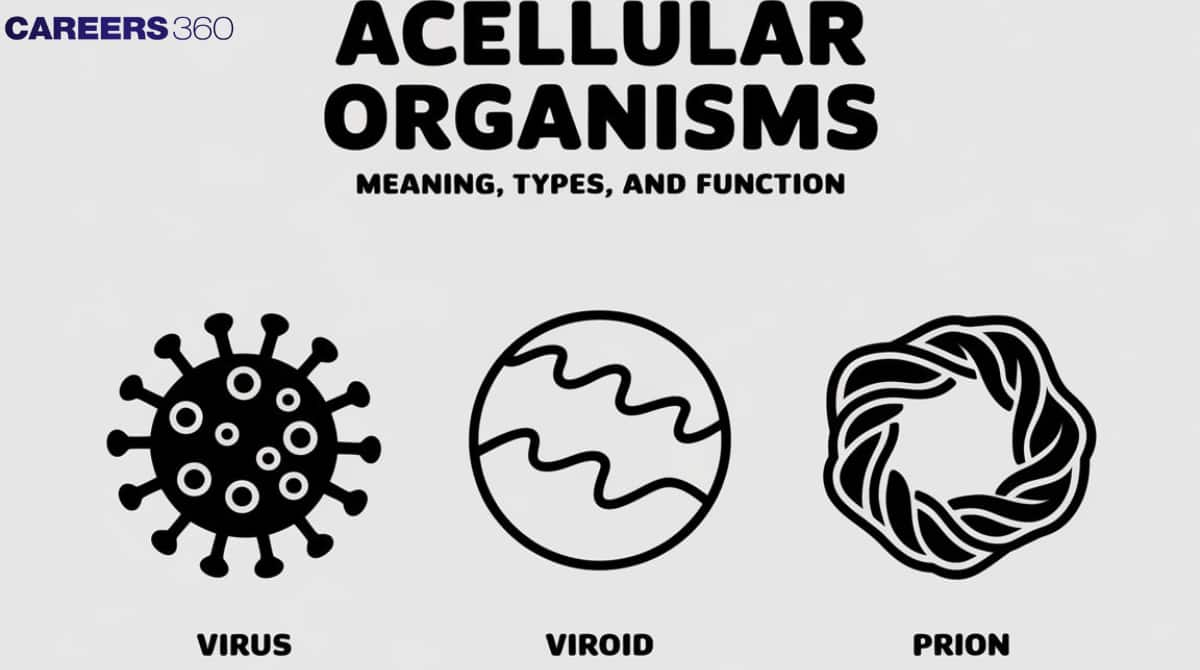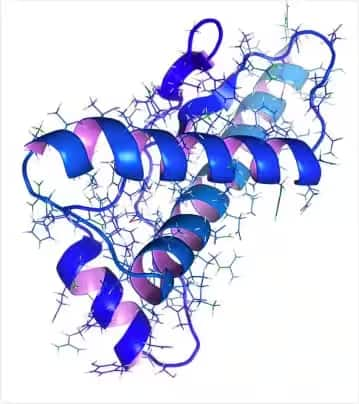Acellular Organisms - Meaning, Types and Function
Cell: All the basic things that take place in a living body are performed in the fundamental unit of the living system known as the ‘Cell’. The cell was first discovered by Robert Hook. There is a life which exists on the Earth which is supported by various living and non-living things. When we talk about which thing these living and non-living things are made up of. So the answer is non-living things are made up of the fundamental unit of matter which is the “atom”. Acellular also refers to substances which are not considered completely living or cells like viruses and various vaccines. Acellular Organisms is one of the most important topics in biology. The chapter carries a weightage of 5% of the total marks in NEET and 4-5% of the weightage of other entrance exams like Paramedical and Pharmacy.
Don't Miss: Most scoring concepts for NEET | NEET papers with solutions
NEET 2025: Syllabus | PYQs | Crack NEET in 2 months - Study Plan
NEET Important PYQ & Solutions: Physics | Chemistry | Biology | NEET PYQ's (2015-24)
- Acellular – Meaning
- Viruses
- Cellular and Acellular
- Tips, Tricks, and Strategies for Acellular Organisms

Some fundamentals of the cell are discussed below:
The cell is the place where all the metabolic and chemical reactions take place.
The cell has cell organelles which have specific functions. Like plasma membrane allows the entry and exit of food and waste.
Cells produce some compounds that are also known as acellular components.
The cell membrane acts as a barrier which protects the internal components of the cell.
Sales also help in regulating the movement of substances both in and out through the process like diffusion osmosis and active transport.
Division of cells takes place through mitosis where growth and repair of the cell while reproduction meiosis takes place.
Acellular – Meaning
In biology, the term "acellular" defines anything that is not made of or divided into cells. It describes entities like viruses, viroids, and prions, which lack a cellular structure and do not perform independent life processes. These acellular forms rely on host organisms for survival and reproduction.
What are Acellular Organisms?
Acellular organisms lack a cellular structure, in contrast to typical living organisms that comprise one or more cells. Examples of such organisms are viruses, viroids, and prions. These do not have their own cellular machinery, like organelles or enzymes, to maintain independent life, and hence they rely on host cells for reproduction and metabolic activities.
Acytota and Cytota
Acytota and Cytota are the two fundamental biological categories. Acytota is made up of acellular entities, such as viruses, viroids, and prions, that have no cellular structure and must use a host organism for their survival. Cytota includes all forms of cellular life, ranging from prokaryotes to eukaryotes, having distinct cellular structures and thus having independent metabolic functions. This allows us to distinguish cellular life from acellular life.
Viruses
About Virus
Viruses represent an intermediary position between living and non-living objects. They constitute a nucleic acid, namely either DNA or RNA, together with a protein coat known as the capsid, surrounded in some by a lipoidal envelope. Viruses can only reproduce within their host cells; they carry numerous diseases, such as the flu, HIV, and COVID-19, amongst others.
Virus – Structure and Components
Since, the living things are made up of cells or they are also referred to as cellular organisms which can be divided into various cells. But the term which is used to describe a single unit of cell which exists in a single unit is known as the acellular organisms. Basic examples of acellular organisms are discussed below:
Viroids

Viroids Small circular single-stranded RNA molecules without any protein coat.
Replicate using host cell machinery but are not able to encode any protein.
Commonly seen in infected plants and causes diseases like potato spindle tuber and citrus exocortis.
Prions

Prions are a kind of abnormal infectious protein which causes neurodegenerative diseases in animals.
It induces itself by misfolding of normal cellular protein leading to harmful aggregates which accumulate in the brain and cause death of the cell.
Cellular Organisms
These organisms have cell membranes and cellular structures.
They carry out all the processes of life independently or with a host in case of any virus.
Also Read:
Cellular and Acellular
The basic difference between Cellular and Acellular is discussed below in the table:
Cellular Organisms | Acellular Organisms |
|
|
|
|
|
|
|
|
|
|
|
|
|
|
|
|
Tips, Tricks, and Strategies for Acellular Organisms
It takes effort to remember everything in a single go. We made the entire problem easy. Some of the tricks regarding Acellular Organisms are given below which you can use to memorise the important points.
Viral Life Cycle
"AEAR: Attachment, Entry, Assembly, Release"
A: Attachment (virus attaches to host cell surface)
E: Entry (viral genetic material enters the host cell)
A: Assembly (new viral particles are assembled within the host)
R: Release (new viruses are released from the host cell)
Viral Structure
"PCG: Protein, Capsid, Genetic Material"
P: Protein coat (protects the viral genetic material)
C: Capsid (the protein shell surrounding the genetic material)
G: Genetic material (DNA or RNA, contains instructions for replication)
Prion Diseases
"MISC: Misfolding, Infectious, Spongiform, Creutzfeldt-Jakob"
M: Misfolded proteins
I: Infectious
S: Spongiform degeneration
C: Creutzfeldt-Jakob disease
Viroid Characteristics
"SSTR: Small, Single-Stranded, Transmit, RNA"
S: Small
S: Single-Stranded RNA
T: Transmit
R: RNA
Acellular vs Cellular Organisms
"NSNR: No Structure, No Metabolism, Replication, Requires Host"
N: No cellular structure
S: No independent metabolism
N: No reproduction
R: Requires host
Also Read
Frequently Asked Questions (FAQs)
Viruses are the pathogens which are made up of a protein coat and genetic material which may be DNA or RNA. The viruses are not viable in the environment they become when they enter the host. They are made up of only protein and DNA/RNA and they replicate inside the host by using the energy from the host. Hence, viruses are known as acellular.
Protozoans are the eukaryotic microorganisms which exist mainly as unicellular. The maximum protozoans are pathogenic in nature and have the protoplasmic level of organization and in case of Amoeba the body is not limited to the cytoplasmic boundaries so it is regarded as the acellular.
Cell is a basic fundamental living unit present in a living body. Cell was discovered by Robert Hook when he observed a honeycomb structure in a microscope invented by him.
These are the organisms which cannot be divided into discrete cells or it may be a something like an organic material but not consists of individual cells.
Unicellular organisms consist of single cell microorganisms which can have single cells like amoeba. Acellular means the non living thing which does not contain any type of cell or it may not be divided into cells hyphae produced by fungi.
Also Read
30 Nov'24 12:23 PM
28 Nov'24 05:34 PM
25 Nov'24 05:18 PM
23 Nov'24 10:02 AM
22 Nov'24 01:59 PM
21 Nov'24 04:58 PM
16 Nov'24 01:58 PM